Militaria, horse harnesses and military equipment from Roman Mainz
Romanisation and urban development in the shadow of the Roman army: a case study of Mogontiacum/Mainz
In view of modern overbuilding, knowledge about the topography of ancient Mogontiacum/Mainz as well as about the type and distribution of areas of civilian and military use outside the known military installations unfortunately remains insufficient.
The most important basis for interpreting the often sparse archaeological features is a comprehensive analysis of the extensive small finds. This is what the present project aims to accomplish for the early to late Imperial Roman militaria and the other pieces of equipment that were probably used for military purposes. Not only the current holdings of the local archaeological heritage department and the Landesmuseum Mainz will be taken into account, but also collections in private hands as well as those objects that have been sold or handed over to many European museums since the nineteenth century.
The spectrum and distribution of the numerous small military finds, as well as their relationship to confirmed archaeological settlement features, give us cause to expect important insights into the origins and topography of the Mainz garrison site established under Emperor Augustus and its further development up to the beginning of the Early Middle Ages.
Mainz thus offers a rare opportunity to examine the development of a civilian city dominated by the military in the long term and to shed light on the closer cultural influence of the Roman army within the Romanisation process of the border provinces.
- Copy link
- Print article
Contact
- Dr. Christian Miks
- +49 6131 8885-119
- Kontakt
- Generaldirektion Kulturelles Erbe Rheinland-Pfalz (GDKE), Dir. Landearchäologie

